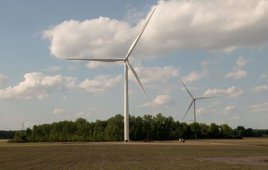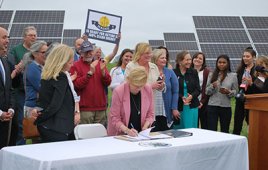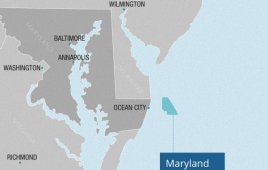
The two new units at Southern Power's Plant Vogtle will each be capable of 1,100 MW.
Good news for the atomic industry, says the Association of Corporate Counsel online. For the first time in 30 years, the United States has approved construction of new nuclear power units, actually additions to an existing Georgia facility. When completed–owners expect Unit 3 of the additions to begin operating in 2016 and Unit 4 in 2017–the plant will provide a reliable base load of about 1,100 MW per unit. Georgia’s growing economy will need the power. And what a bargain: Only $14 billion.
To play the devil’s advocate, let’s assume cost overruns are only 30%. That brings the price tag to about $18.2 billion. And there is plenty of optimism in those completion dates, too, so lets push them back at least two years each (Now I’m the optimist.) to 2018 and 2019.
Here’s the math: For kicks, let’s spend the $18.2 billion on an equivalent value of wind turbines at, say, $2 million/MW. How much nameplate wind power, P, could we buy?
P = $18.2 x 109 / ($2 x 106 per MW)
= 9.1 x 103 MW
That is, 9,100 MW of turbines.
Also assume the turbines are on average 2-MW units. That would mean an order of 4,550 turbines.
If all were of the same model, the price ($2 million/MW) could drop considerably. In fact, a 1,000-turbine order to one OEM would make them giddy and likely earn a hefty discount. But let’s be conservative. If the order were split among several OEMs, initial wind-turbine deliveries might start producing power in two years (2014) and finish in three more, about 2017, likely before the first atomic addition, Unit 3, goes online in the quite optimistic 2018.
Although the new atomic plants will deliver reliable power the nation needs, they will do so at considerable cost. One thought from the above scenario would be to build one atomic unit and complement the other half in wind turbines. The two technologies would benefit each other nicely.
Wind power is now less expensive than atomic power and the price differential will only widen as developments in the pipeline are built into new turbines.
Of course, wind power will never replace atomic power. That would be just crazy.
–Paul Dvorak
Filed Under: Uncategorized





Thanks all for the great, insightful, and technical comments. As a wind advocate, I’m fully aware of the variable nature of wind power. That means a reliable method will be needed to supply the base load and one that can cycle up and down quickly. That points to a natural gas powered plant, and possibly a new feature on a nuclear plant.
Nuclear does get a bum rap and mostly for having to meet pages upon pages of environmental (not always clear or fair) regs and studies and lawsuits. I think the small modular reactors are the way to go to trim expenses and the cost of transmission lines.
What do you think?
People forget that it is the investor’s decision: there is no opportunity cost in investing in nuclear power and/or renewables. For example, UniStar (a French Electricity/EdF subsidiary) was barred from constructing its US-EPR (1600 MW reactor) for its mainly foreign ownership: despite seeking US-companies to construct and assemble its EPR variant. Considering US laws require nearly 50% US equity (China requires 75%) EdF pulled the plug on US operations. Delays in the US-EPR certification from the NRC have not helped either.
WOW!! is right. How much are the Nuke guys paying these bloggers? Did you know that wind turbines can also be used to pump, filter and electrolyze water (clean or dirty) into hydrogen? That can be used to run any large diesel generator or turbine power gen, in fact on h2 they run even better. That will be more than adequate to provide the base line V,I, F, power factor correction and reserve.
How many people work for 1 nuke plant vs. technicians and much more for home grown wind and other RE to produce equal power?. You complain about the jobless rate and a sinking economy, yet give such INTELLIGENT comments about something they really know NOTHING about.
All these HIGHLY intelligent bloggers won’t have much to say when their members drop out of their pants from radiation. They will more than likely be the same bloggers to scream bloody murder as to why we had nuclear in the first place.
We should have stuck with Tesla and his truly Green, clean, sustainable ideas.
BTW say hi to Excelon while you are at it, they would be proud of you bloggers.
By 60 years the naked illiterate populace will be flinging the waste from the cooling pools at each other. 🙂
Mr. Selsam:
Gee, I hope not, but still it’s good to hear from you.
Paul
Oh, and I forgot to mention capacity factor. According to the US Energy Information Administration (EIA), in 2010 the capacity factors were as follows:
Nuclear – 91.2%
Biomass – 85.5%
Geothermal – 71.6%
Coal (Steam Turbine) – 65.4%
Coal (Combined Cycle) – 45.*%
Hydro – 29.4%
Wind – 29.1%
Solar – 17.7%
Gas (Steam Turbine) -12.9%
Oil (Steam Turbine) -8.9%
Seems to me over just a few years time, that “expensive” nuclear plant is going to run laps around that imaginary 4,550 turbine wind farm.
New nuclear needs to be in our energy mix. Further, I think it is important that the US build a few plants so that we will maintain expertise in this important energy field.
What is the duty factor for the 1,100 MW per nuclear unit? They are generally > 90%, yes? What’s the comparable factor for wind turbines in a location practical to support the planned demand? It can be considerably lower averaged over 24 hrs, and even lower in a narrower window in late afternoon/early evening when demand peaks are highest. I think there is a bit more math to be done here.
Wow Paul, that 7 years of ME experience really paid off. You estimated a 30% cost overrun for a non-government project, and 50% increase in schedule. You must have been managing large scale construction projects. By the way, you forgot to include the cost for land required to site the 4,550 wind turbine units and ancillary equipment. Will there be any room left for the people of Georgia? If you have full production for 25% of the time, what will be the price to supplement the power output for the other 75%? Will the people be required to do without power during those periods? I don’t have your skills with math, so you will have to run these new numbers for me.
I presume that you are also factoring in the average life of a wind farm being 20-30 years versus 60 years with a nuke, while you will be more than happy to tie your mother’s electronic life-saving device to the “consistent energy flow” of a wind turbine versus the 24×7 energy flow of a nuclear generating unit.
Note that cost overruns in the 70’s and 80’s were also largely resulting from constant engineering changes while they were building the units versus the modeled pre-design engineering in effect today.
I understand that you’re just poking fun at nuclear power, but the last time I checked, we don’t have to worry about the wind blowing or not blowing in order to put out 1,200+ MWe from a foot print of less than 100 acres of actual used land. Last time I checked, it takes slightly more land than that to generate the equivalent amount of electricity from wind. How about we recognize that nuclear power is a great baseload source of clean electricity for the time being (like maybe the next 50 years or so). At some point, we will figure out how to store wind, solar, and tidal energy, but for now, we need either nuclear, coal, gas, or hydro power. When you look at MWe per square mile as well as long-term impact on the environment as a whole, nuclear wins.
Wind will be no replacement for base load generation until there is a suitable way to store what is generated. It also only produces nameplate output at a very optimistic windspeed so it would take 4 times as many units at average winds to procuce what is stated above.
But Paul, even 9000+ MW of wind cannot regulate or control the grid in terms of voltage and frequency like a nuclear plant can. The more wind you have the more valuable a large synchronous driven base load plant is for grid stability. Until wind can prove that it can regulate the grid like a base load plant, the comparison with wind and nuclear or coal on just MW numbers will not be valid. Wind being able to regulate and stabilize a grid similar to a large base load plant may come but its not here yet nor even in any great measure by the 2018 time frame of this plant.